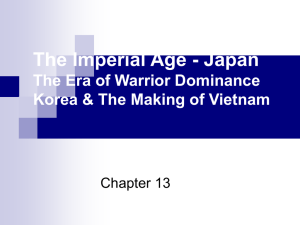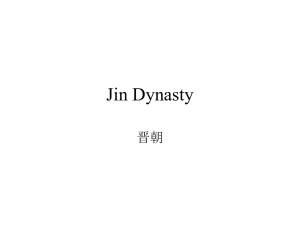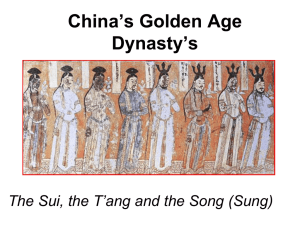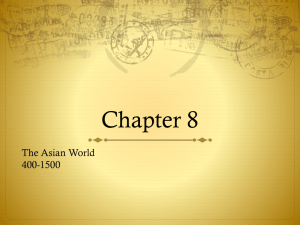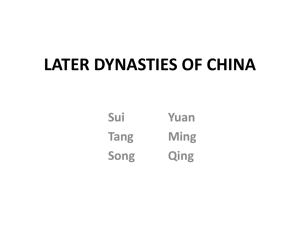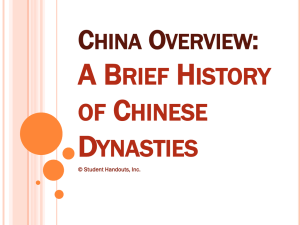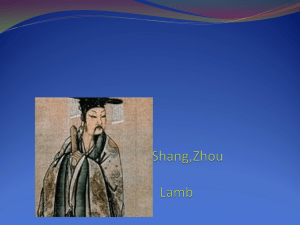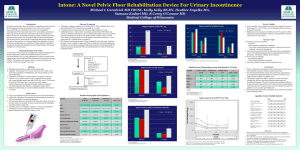5.1_Sui Dynasty
advertisement
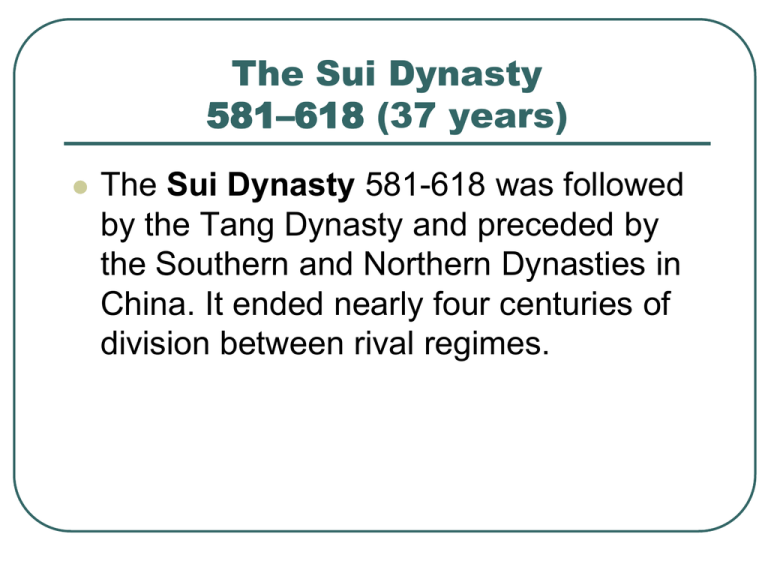
The Sui Dynasty 581–618 (37 years) The Sui Dynasty 581-618 was followed by the Tang Dynasty and preceded by the Southern and Northern Dynasties in China. It ended nearly four centuries of division between rival regimes. Usurpation vs. Legitimacy Usurpation 篡夺: illegal seizure and occupation of a throne; wrongful or illegal encroachment, infringement, or seizure. Yang Jian usurped the throne from his daughter’s young son and proclaimed himself emperor (89) Political Legitimacy 合法性/正统性, Acceptance of authority Sources of legitimacy: Government by consent (John Locke) Beneficial Consequences Public reason and democratic approval Consequentialism 1. the theory that human actions derive their moral worth solely from their outcomes or consequences. 2. the theory that ethical decisions should be made on the basis of the expected outcome or consequences of the action. Deng Xiaoping: It doesn’t matter whether it is a while or black cat. As long as it catches rats, it is a good cat. What’s so problematic about consequentialism? Intension/motive & means by which to reach one’s goals… Emperor Wen of Sui (Ebrey 89-90) Yang Jian (541-604) 隋文帝杨坚 founder and first emperor of China's Sui Dynasty. Three means/strategies to unify the country (after 300 years of division): military/cultural/diplomatic He used patronage of Buddhism to build links to prominent families in the Southern Dynasties. He had Yang Guang (his son 569-617) marry a princess from one of the Southern royal houses. The Universal Appeal As Cakraꞌvartin king (89), (in Indian philosophy, politics, etc.) an ideal, universal, enlightened ruler, under whom the world exists in justice and peace. http://dictionary.referen ce.com/browse/Cakrav artin?s=t The (Western) Roman Catholic Church stressed on universality for broader appeal; The Eastern (Orthodox) Roman Empire (the Great Schism or the East-West Schism in 1045 AD) emphasizes on authenticity; Judea (Judaea or Iudaea) as the birthplace of Christianity Yang Jian’s Four Main Initiatives Yang Jian undertook four main initiatives in developing his new dynastic order. 1. He promulgated a new legal code--The Kaihuang era开皇之 治 & the Kaihuang (Legal) Code, in 500 articles, providing a coherent body of law and administration throughout the empire; this paved the way for the Reign of Zhenguan 贞观之治 in the Tang Dynasty 627-649. 2. He adopted the so-called “well-field” system of land tenure, in which land was apportioned by the state every few years to prevent the accumulation of great estates in the hands of powerful families (“local snakes”) that might challenge imperial power. Yang Jian’s Four Main Initiatives 3. Establishment of agricultural colonies for border defense—soldiers supported themselves by farming rather than depending on the state (Cao Cao had something similar: farmer-soldier concept); 4. Intervention of agricultural economy: Establishment of public granaries to store grains for time of famine or food shortage, and for transporting grains from southeast to northeast to keep prices rising from too far—this echoes what Emperor Wu of Han did in the Han Dynasty The Kaihuang Era (581 AD) 开皇之治 Emperor Wen of Sui 1. Simplified the government--“ten sheep nine shepherds”— “十 羊九牧”: rid the nine rank system (220 AD) 九品中正制; replaced with three branches/six departments system or three departments/six-minister system; 2. Established the imperial (civil service) examination; 3. Fubing system 府兵制 (farmer/soldier) 4. During his reign, he began the construction of the Grand Canal (Ebrey et al 306/377). Impressive ship building Yang Jian was famous for having the fewest number of concubines for an adult Chinese emperor in Chinese history. The Jing - hang Grand Canal 京杭大运河 1,776 km (1,103 miles) 南粮北调 Dispatch/Supply food to the north from the south Starting at Beijing, it passes through Tianjin and the provinces of Hebei, Shandong, Jiangsu and Zhejiang to the city of Hangzhou. The oldest parts of the canal date back to the 5th century BC, although the various sections were finally combined during the Sui Dynasty (581–618 AD). Emperor Yangdi of Sui dynasty (605) Nine-rank system (Ebrey 89) & Imperial Examinations Nine-rank system The nine rank system controller system, was a civil service nomination system during the Three Kingdoms and the Southern and Northern Dynasties in China. Theoretically, local government authorities were given the task of selecting talented candidates, then categorizing them into nine grades depending on their abilities. In practice, however, only the rich and powerful would be selected. Abolished in Sui Dynasty The Imperial Civil examinations determined who among the population would be permitted to enter the state's bureaucracy. The Imperial Examination System in China lasted for 1300 years, from its founding during the Sui Dynasty in 605 to its abolition near the end of the Qing Dynasty in 1905. Guozijian 国子监 The Guozijian (simplified Chinese: 国子监; traditional Chinese: 國子監; pinyin: guózǐjiàn), or Kuo Tzu Chien, the "School of the Sons of State,” sometimes called the "Imperial Academy", "Imperial College", "Imperial School" , "Imperial University" or "Imperial Central University", was the national central institute of learning in Chinese dynasties after the Sui. It was the highest institute of learning in China's traditional educational system. From Guozijian to the Imperial Capital Academy Formerly it was called the Taixue, while Taixue for Gongsheng (tribute students) from the populace was still part of Guozijian, along with Guozixue for noble students. The central schools of taixue were established as far back as 3 CE, when a standard nationwide school system was established and funded during the reign of Emperor Ping of Han 汉平 帝. When disbanded during the 1898 reform of the Qing Dynasty, the Guozijian was replaced by the Imperial Capital Academy 京 师大学堂, later known as Peking University, now Beijing University. Thirteen Classics Steles Engraved with the "Thirteen Classics" Xiꞌan Shijing (詩經) The Book of Poetry Shujing (書經) The Book of Documents Zhouli (周禮) The Rites of Zhou Yili (儀禮) The Ceremonies and Rites Liji (禮記) The Record of Rites Yijing (易經) The Book of Changes (which influenced The Art of War and other works) Thirteen Classics Zuo Zhuan (左傳) The commentary of Zuo Gongyang Zhuan (公羊傳) The commentary of Gongyang Guliang Zhuan (穀梁傳) The commentary of Guliang Lunyu (論語) The Analects Erya (爾雅) Luxuriant and Refined Words Xiaojing (孝經) The Classic of Filial Piety Mengzi (孟子) The Mencius Steles 石碑 an upright stone slab or pillar bearing an inscription or design and serving as a monument, marker, or the like. The Stele Forest, or Xi'an Beilin Museum (碑林; pinyin: Bēilín) Founded in 1306 One of the main halls of the Guozijian in downtown Beijing Beijing Guozijian The paifang or archway in Beijing's Guozijian street, where the imperial college is located. 牌坊【páifāng】 memorial archway (or gateway). Limitations Since the Ming Dynasty, the exams have become rigid, ossified, and formularized. Content and form Eight-legged essay, comparable to the fiveparagraph essay Form takes over substance 八股文【bāgǔwén】 eight -part essay; stereotyped writing. Termination of the Imperial Examinations (1905) In August 1905, Yuan Shikai 袁世凯 et al proposed the imperial examinations be terminated. It is too slow a move to train talents needed; It is useless; Priority be given to popular education Yuan Shikai Declared himself as Emperor 1 January 1916 – 22 March 1916 Yuan Shikai made his name by training the new army and controlling tax in Korean Peninsula After the 1911 Revolution, became President of the Republic of China Emperor Yang of Sui (隋煬帝, 569 - April 11, 618), personal name Yang Guang (楊廣), alternative name Ying (英), nickname Amo (阿摩), known as Emperor Ming (明帝) during the brief reign of his grandson Yang Tong), was the second son of Emperor Wen of Sui, and the second emperor of China's Sui Dynasty. Patricide (killing one’s father) Fratricide (killing one’s brothers) Filicide (killing one’s own children) (in this case, Yang Guang killed his brother’s sons (his nephews); Nepotism refers to Pope’s promotion of his nephews; Military expeditions to Korea The Grand Canal 隋炀帝 杨广 (569 -618) Portrait painting of Emperor Yang of Sui, commissioned in 643 by Taizong, painted by Yan Liben (600-673) Yang Guang’s Achievements “修通运河”、 “西巡张掖”、 “开创科举”、 “开发西域”、 “东征高丽” The downside: Heavily burdened his subjects; Construction of the Grand Canal; Westbound Inspection of Zhangye: the silk road; Pioneered the Imperial Examinations; Opening up the west by conquering Khitans; 3 Eastern expeditions (607/612/613) to fight Korea
